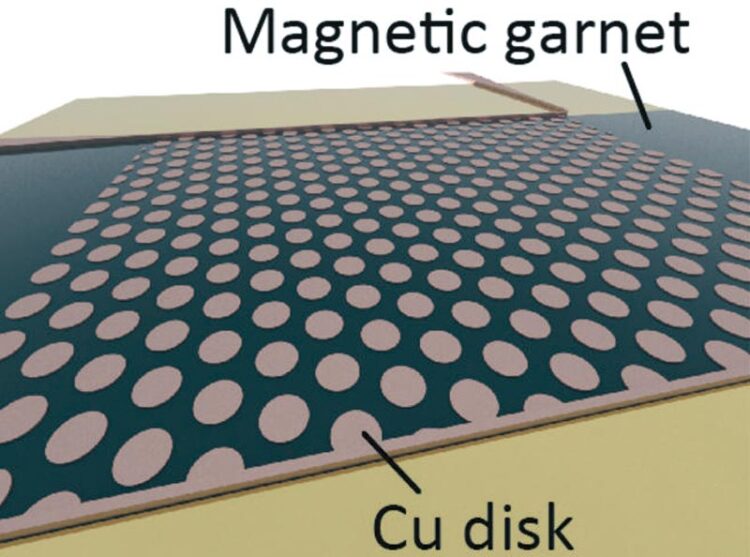Hexagonal copper disk lattice unleashes spin wave control

An illustration of the two-dimensional magnonic crystal developed in this study, viewed from an oblique angle. Copper disks are periodically arranged on a magnetic garnet film.
Credit: Taichi Goto et al.
A collaborative group of researchers has potentially developed a means of controlling spin waves by creating a hexagonal pattern of copper disks on a magnetic insulator (shown in Figure 1). The breakthrough is expected to lead to greater efficiency and miniaturization of communication devices in fields such as artificial intelligence and automation technology.
Details of the study were published in the journal Physical Review Applied on January 30, 2024.
In a magnetic material, the spins of electrons are aligned. When these spins undergo coordinated movement, it generates a kind of ripple in the magnetic order, dubbed spin waves. Spin waves generate little heat and offer an abundance of advantages for next-generation devices.
Implementing spin waves in semiconductor circuits, which conventionally rely on electrical currents, could lessen power consumption and promote high integration. Since spin waves are waves, they tend to propagate in random directions unless controlled by structures and other means. As such, elements capable of generating, propagating, superimposing, and measuring spin waves are being competitively developed worldwide.
“We leveraged the wavelike nature of spin waves to successfully control their propagation directly,” points out Taichi Goto, associate professor at Tohoku University’s Electrical Communication Research Institute, and co-author of the paper. “We did so by first developing an excellent magnetic insulator material called magnetic garnet film, which has low spin wave losses. We then periodically arranged small copper disks with diameters less than 1 mm on this film.”
By arranging copper disks in a hexagonal pattern resembling snowflakes, Goto and his colleagues could effectively reflect the spin waves. Furthermore, by rotating the magnonic crystal (shown in Figure 2) and changing the incident angle of spin waves, the researchers revealed that the frequency at which the magnonic band gap occurs remains largely unchanged in the range from 10 to 30 degrees. This suggests the potential for the two-dimensional magnonic crystal to freely control the propagation direction of spin waves.
Goto notes the novelty of their findings: “To date, there have been no experimental confirmations of changes in the spin wave incident angle for a two-dimensional magnonic crystal comprising a magnetic insulator and copper disks, making this the world’s first report.”
Looking ahead, the team hopes to demonstrate the direction control of spin waves using two-dimensional magnonic crystals and to develop functional components that utilize this technology.
DOI: 10.1103/PhysRevApplied.21.014061
Article Title: Orientation-dependent two-dimensional magnonic crystal modes in an ultralow-damping ferrimagnetic waveguide containing repositioned hexagonal lattices of Cu disks
Article Publication Date: 30-Jan-2024
Media Contact
Public Relations
Tohoku University
public_relations@grp.tohoku.ac.jp
All latest news from the category: Physics and Astronomy
This area deals with the fundamental laws and building blocks of nature and how they interact, the properties and the behavior of matter, and research into space and time and their structures.
innovations-report provides in-depth reports and articles on subjects such as astrophysics, laser technologies, nuclear, quantum, particle and solid-state physics, nanotechnologies, planetary research and findings (Mars, Venus) and developments related to the Hubble Telescope.
Newest articles

High-energy-density aqueous battery based on halogen multi-electron transfer
Traditional non-aqueous lithium-ion batteries have a high energy density, but their safety is compromised due to the flammable organic electrolytes they utilize. Aqueous batteries use water as the solvent for…

First-ever combined heart pump and pig kidney transplant
…gives new hope to patient with terminal illness. Surgeons at NYU Langone Health performed the first-ever combined mechanical heart pump and gene-edited pig kidney transplant surgery in a 54-year-old woman…

Biophysics: Testing how well biomarkers work
LMU researchers have developed a method to determine how reliably target proteins can be labeled using super-resolution fluorescence microscopy. Modern microscopy techniques make it possible to examine the inner workings…





















